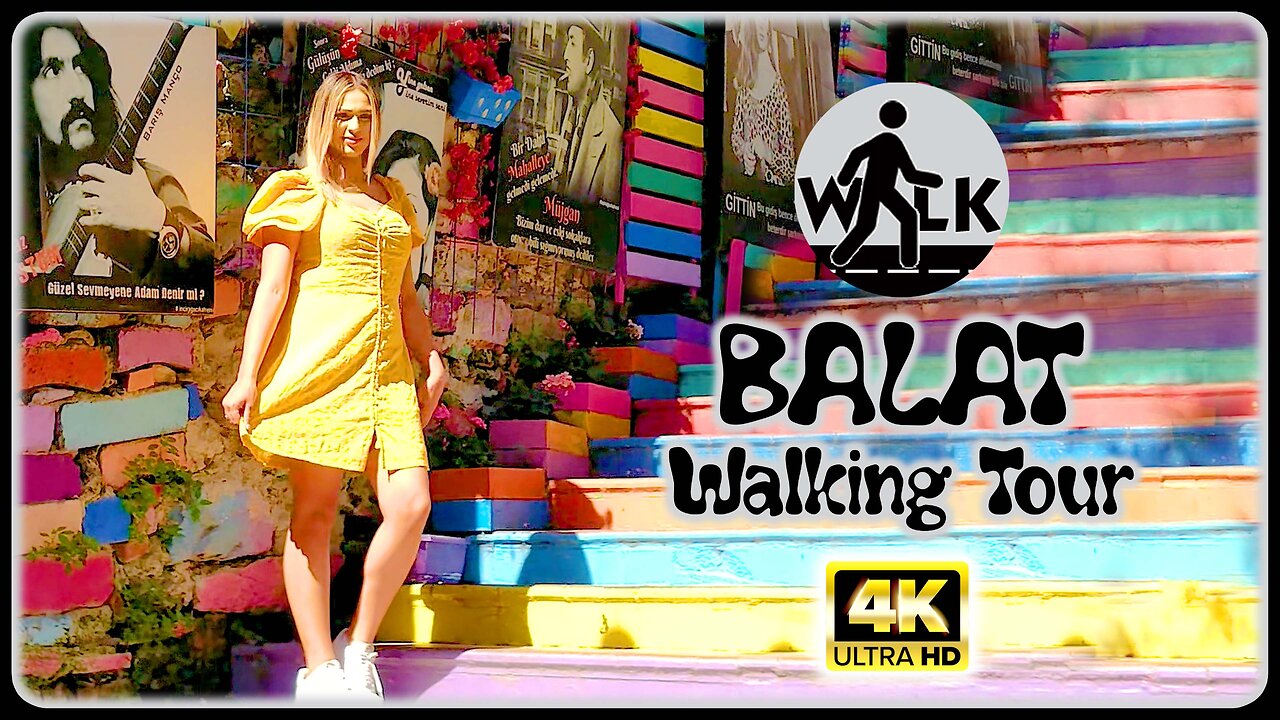Premium Only Content

Balat in Istanbul Walking Tour (World Heritage Site) Trip / Travel - 4K UHD
Walk with me 👉 https://bit.ly/3O7D0vg
My walk map 👉 https://bit.ly/39d4hxW
Balat is in the old city on the European side of Istanbul, on the western shore of the Golden Horn, sandwiched between Fener and Ayvansaray. Historically, it was the centre of the Jewish community in Istanbul.
The name Balat is probably derived from Greek palation (palace), from Latin palatium, after the nearby Palace of Blachernae.
As in neighbouring Fener, Balat's back streets are lined with small stone two and three-storey terraced houses and a few grander mansions. in the 2010s Balat become one of the hottest parts of the city for tourism, including domestic tourism, and many of the houses have been turned into cafes, restaurants and accommodation for visitors. Many of the houses have been repainted in bright colours to give a distinctive feel to the neighbourhood.
Balat is a stop on the T5 tramline connecting it to Cibali and the small bus terminal (for services to Anatolia) in Alibeyköy. The Golden Horn ferries also stop here, connecting Balat to Üsküdar, Karaköy, Kasımpaşa, Fener, Ayvansaray, Hasköy, Sütlüce and Eyüp.
History
A photograph of the Bulgarian St. Stephen Church, also known as the Bulgarian Iron Church of St Stephen of the Bulgars, also known as the Bulgarian Iron Church
Balat first became home to a large Jewish population in the late 15th century, when Sultan Bayezid II offered citizenship to Jewish and Muslim Jews fleeing the Inquisition in Spain and Africa, and the 1492 Alhambra Decree. At its peak, Balat was home to 18 synagogues, though only two are still in use today: Ahrida Synagogue and Yanbol Synagogue. Opened in 1899 and designed by Gabriel Tedeşci, Or-Ahayim Hospital was originally set up to serve Balat's Jewish population, but now serves the general public.
Balat was also home to a wide variety of ethnicities, cultures and religions. The famous Bulgarian Iron Church is located in the district, and there was traditionally a sizeable Armenian population too. Its proximity to St. George's Church and the Ecumenical Patriarchate of Constantinople in neighbouring Fener also meant that there was a large Greek Orthodox (Rûm) population. However, Balat today is overwhelmingly Muslim, with most minority populations having left the district or been forced to leave as a result of the Armenian genocide, Greek genocide, anti-Greek riots and expulsions throughout the 20th century.
From the 17th century onwards European travellers recorded Balat as being particularly poor and unhygienic, although Marie-Christine Bornes-Varol has argued that their reports may not have been accurate reflections of Balat as a whole, since travellers' accounts were largely based on visits to Karabaş, the poorest part of Balat.
In 1810 Balat's Jews attacked the Janissary patrols in the neighbourhood, claiming that they were defending themselves against mistreatment by the local Janissary unit; those who were caught after the attack were executed.
In 1985, Balat was inscribed on the UNESCO World Heritage List as one of the Historic Areas of Istanbul, and in the late 1990s and early 2000s was the subject of a number of controversial renovation and revitalisation projects.
Social Media / Contact
Twitter : https://twitter.com/travelwalking
Instagram : https://www.instagram.com/earthtravelwalkingtours
Facebook : https://www.facebook.com/Earth-Travel-Walking-Tours-102888222457618
Web : http://www.earthtravelwalkingtours.com
E-mail : earthtravelwalkingtours@gmail.com
-
 55:07
55:07
LFA TV
1 day agoDefending the Indefensible | TRUMPET DAILY 2.25.25 7PM
16.5K12 -
 6:09:26
6:09:26
Barry Cunningham
11 hours agoTRUMP DAILY BRIEFING - WATCH WHITE HOUSE PRESS CONFERENCE LIVE! EXECUTIVE ORDERS AND MORE!
61.6K42 -
 1:46:37
1:46:37
Game On!
6 hours ago $2.94 earnedPUMP THE BRAKES! Checking Today's Sports Betting Lines!
29.5K1 -
 1:27:21
1:27:21
Redacted News
5 hours agoBREAKING! SOMETHING BIG IS HAPPENING AT THE CIA AND FBI RIGHT NOW, AS KASH PATEL CLEANS HOUSE
159K197 -
 1:08:28
1:08:28
In The Litter Box w/ Jewels & Catturd
1 day agoCrenshaw Threatens Tucker | In the Litter Box w/ Jewels & Catturd – Ep. 749 – 2/25/2025
93.9K48 -
 44:57
44:57
Standpoint with Gabe Groisman
1 day agoWill Byron Donalds Run for Florida Governor? With Congressman Byron Donalds
46.4K7 -
 1:06:25
1:06:25
Savanah Hernandez
5 hours agoEXPOSED: FBI destroys evidence as NSA’s LGBTQ sex chats get leaked?!
69.8K26 -
 1:59:58
1:59:58
Revenge of the Cis
6 hours agoEpisode 1452: Hindsight
59.9K7 -
 1:20:35
1:20:35
Awaken With JP
8 hours agoCrenshaw Threatens to Kill Tucker and Other Wild Happenings - LIES Ep 80
124K72 -
 1:32:19
1:32:19
Russell Brand
7 hours agoBREAK BREAD EP. 15 - LECRAE
129K10